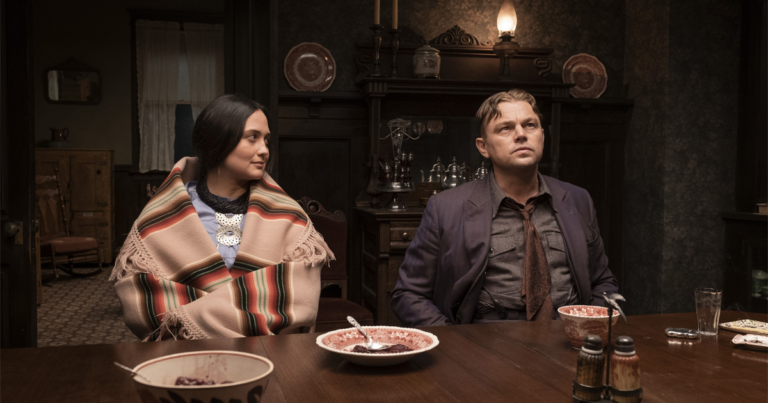Director: Martin Scorsese
Screenplay: Eric Roth, Martin Scorsese
Cast: Lily Gladstone, Robert De Niro, Leonardo DiCaprio
Duration: 206 mins
Showing at: Theatres
In Martin Scorsese’s “Killers of the Flower Moon,” four Osage sisters embody a rich tapestry of character and culture while humorously observing the pursuits of white men after their wealth. The narrative unfolds during the 1920s in Oklahoma, highlighting the opulence and subsequent targeting of the Osage Indians following oil discoveries on their land. This tragic period, known as the Reign of Terror, reveals a stark contrast between the Osage’s affluence and the violent greed of white Americans.
The film, inspired by David Grann’s book, extends beyond a murder mystery to portray a detailed and respectful homage to the Osage community. The narrative, however, primarily unfolds through the white characters’ perspectives, particularly Leonardo DiCaprio’s Ernest – torn between his community’s expectations and his complex affection for Mollie (Lily Gladstone).
Despite the focus on its white characters, the film doesn’t shy away from depicting the Osage’s plight, illustrating both their wealth and victimization. It also critiques the historical silence and complicity surrounding these crimes. Scorsese skillfully employs different cinematic styles, shifting from black-and-white silent film aesthetics to vibrant, immersive scenes, maintaining a gripping narrative.
While the film effectively portrays the Osage tragedy and white immorality, it leaves some longing for deeper insight into the Osage perspective, particularly Mollie’s. Lily Gladstone’s powerful portrayal of Mollie illuminates her character, yet the film primarily orbits around Ernest and William Hale (Robert De Niro), probing their moral complexities more than Mollie’s experiences.
“Killers of the Flower Moon,” while showcasing Scorsese’s adeptness at storytelling and genre-blending, subtly underlines the long-term consequences of historical injustices. The film, enriched by its Native cast and crew, confronts the erasure of indigenous trauma from mainstream history, offering a cinematic reimagining of these untold stories. However, it also acknowledges its limitations, ultimately serving as a thought-provoking piece that merges historical authenticity with the demands of entertainment.


